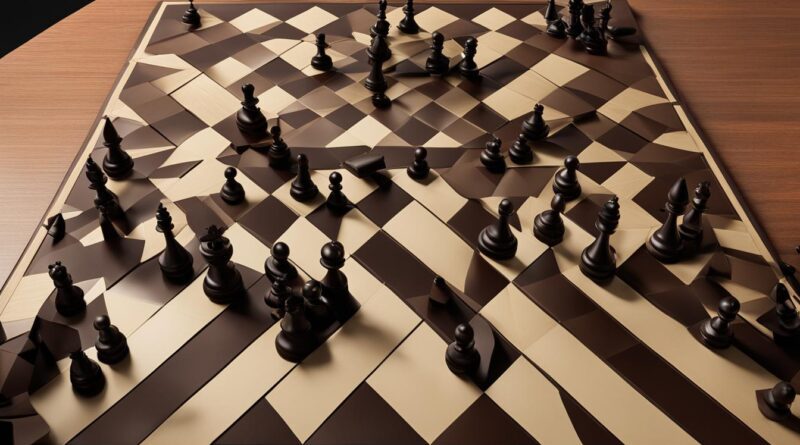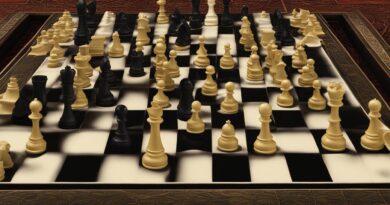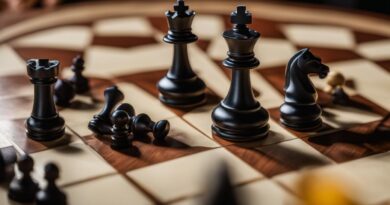Triangulation in Chess: Mastering the Endgame Tactic
Triangulation is a powerful tactic used in chess to force an opponent into zugzwang, or a disadvantageous position where they must make a move. It is particularly effective in endgames, where the placement of the kings and pawns can be crucial. Triangulation involves maneuvering the king in such a way that it forms a triangle on the board, ultimately leading to a winning position when it becomes the opponent’s turn to move. This tactic is also known as losing a tempo or losing a move.
Triangulation in chess is a strategic technique that can give players a winning advantage in endgames. By understanding the fundamental concepts and practicing its execution, players can enhance their game and outmaneuver their opponents.
Key Takeaways:
- Triangulation is a tactic used in chess to force the opponent into zugzwang.
- It involves maneuvering the king to form a triangle on the board.
- Triangulation is most commonly used in endgames.
- Understanding opposition and zugzwang is crucial for successful triangulation.
- Mastering triangulation requires practice and strategic thinking.
The Basics of Triangulation
To understand the concept of triangulation in chess, it is important to grasp the fundamental ideas behind it. Triangulation is a powerful tactic used to force an opponent into zugzwang, a disadvantageous position where they must make a move. This tactic is particularly effective in endgames, where the placement of the kings and pawns can be crucial.
Triangulation involves maneuvering the king in such a way that it forms a triangle on the board. By moving the king along three adjacent squares, the player aims to reach the same position with the opponent’s turn to move. This creates a disadvantage for the opponent, forcing them to make a move that worsens their position. The key to successful triangulation is maintaining opposition and utilizing precise piece placement.
“Triangulation occurs most commonly in endgames. To maintain the basic position, if one king triangulates, he has lost a crucial tempo, and the opponent will gain the upper hand.”
Triangulation is a tactic that requires careful calculation and strategic thinking. By mastering this technique, players can gain a significant advantage in endgames and outwit their opponents on the chessboard.
Example of Triangulation in Action
An example can best illustrate how triangulation works in practice. Consider a position where White has the opposition and it is Black’s move. In this scenario, Black must stay close to their current position to prevent the advancement of White’s pawns and avoid being driven to the edge of the board. However, by using a series of moves to form a triangle with their king, White can force Black into zugzwang. This is achieved by strategically placing the king on three specific squares, such as d5, e5, and d4, and maneuvering it back to the original square. This forces Black to make a move that ultimately worsens their position, leading to a winning advantage for White.
Consider this position: “Black has the opposition and is keeping the white king out. If White had the opposition, the black king would have to move away from d7. However, Black’s king must stay close to prevent the advancement of White’s pawns. The squares d5 and d7 are corresponding squares. White can win by the following maneuver: 1. Ke5! Kc6 2. Kd4 Kd7 3. Kd5… and now the triangulation is complete.”
Another example is from a 1978 game between Lev Alburt and Garry Kasparov. In this game, Black wins by triangulating: 55… Kf5! 56. Kg1 Ke5 and White resigned. These examples demonstrate the effectiveness of triangulation in creating zugzwang and gaining a winning advantage on the chessboard.
Example Position:
Triangulation with the King
Triangulation is a powerful tactic in chess, particularly in the endgame. While it is commonly associated with the king, it can also be employed with other pieces on the board. However, the most common occurrence of triangulation is in king and pawn endgames, where the kings are close to each other. By carefully maneuvering the king on three adjacent squares, the player can form a triangle and gain the opposition, ultimately forcing the opponent into zugzwang. This tactic allows players to control the flow of the game and create a winning advantage by strategically manipulating the position of their pieces.
Triangulation requires precise calculation and strategic thinking. It is crucial to maintain opposition and consider the overall position on the board while executing the maneuver. By creating a situation where it is the opponent’s turn to move, players can force them to make a move that worsens their position. While the examples mentioned earlier focused on the king and pawn endgame, triangulation can also be utilized in other types of endgames and even some middlegames. It is a versatile tactic that can greatly enhance a player’s endgame strategy.
The most common occurrence of triangulation is in king and pawn endgames. Typically, the kings are close to each other, and triangulation allows the player to gain the opposition, putting the opponent in zugzwang. This tactic involves carefully maneuvering the king on three adjacent squares, forming a triangle. By doing so, the player creates a winning advantage by forcing the opponent into a position where any move they make will worsen their position.
It is important to note that triangulation is just one tool in a player’s arsenal and should be combined with other strategic tactics and principles for optimal gameplay. While it can be a powerful tactic, it may not always be the best strategy in every situation. Players should consider the advantages and disadvantages of using triangulation and assess if it is the most efficient approach for their specific game. By practicing and refining their skills in triangulation, players can enhance their endgame strategy and increase their chances of success on the chessboard.
Benefits and Limitations of Triangulation
Like any strategic tactic, triangulation in chess has its benefits and limitations. The main advantage of triangulation is the ability to gain a winning advantage by forcing the opponent into zugzwang. It allows players to manipulate the position of their pieces and control the flow of the game. However, triangulation requires careful planning and precise execution. It may not always be the best strategy in every situation, as there may be more efficient ways to secure victory. Additionally, triangulation may not work as effectively in complex positions with multiple pieces on the board. It is important for players to weigh the pros and cons of using triangulation and determine if it is the optimal choice for their specific game.
Triangulation with Other Pieces
While triangulation is commonly associated with the king, it can also be employed with other pieces on the board. This tactic allows players to gain a positional advantage by manipulating the opponent’s moves and forcing them into zugzwang. One example of triangulation with other pieces is using the queen to gain an advantage over a rook in certain positions. By maneuvering the queen in a triangular pattern, players can force the rook into making undesirable moves, ultimately securing a winning advantage. However, it is important to note that not all pieces can perform triangulation. The knight, with its unique movement pattern, cannot execute this tactic.
Triangulation with pieces other than the king requires precise positioning and strategic thinking. By carefully considering the placement of the pieces and planning their moves accordingly, players can effectively force the opponent into zugzwang and gain a winning advantage. It is essential to evaluate the overall position on the board and weigh the pros and cons of using triangulation in each specific game. While it can be a powerful tactic, it may not always be the most efficient strategy in every situation. Players should consider alternative approaches that may lead to victory more quickly and effectively.
Example of Triangulation with a Rook
One example of triangulation with a rook can be observed in a game between Veselin Topalov and Anatoly Karpov. In this game, white successfully triangulates with the rook to put black in zugzwang. By maneuvering the rook in a triangular pattern, white forces black into making unfavorable moves, ultimately securing a winning advantage. This example demonstrates the effectiveness of triangulation with pieces other than the king and highlights the strategic thinking required to execute this tactic successfully.
In conclusion, while triangulation is commonly associated with the king, it can also be utilized with other pieces on the chessboard. By carefully positioning the pieces and maneuvering them in a triangular pattern, players can force their opponents into zugzwang and gain a winning advantage. However, it is important to remember that not all pieces can perform triangulation, and the decision to use this tactic should be based on a thorough evaluation of the game position. By understanding and practicing triangulation with other pieces, players can enhance their strategic skills and improve their chances of success in the game.
Practical Application of Triangulation
Now that we have explored the basics of triangulation and seen examples of its implementation, it’s time to discuss its practical application in chess. To effectively use triangulation in a game, players need to evaluate the current position on the board, consider the potential advantages and disadvantages of triangulation, and plan their moves accordingly. It requires deep understanding of key concepts such as opposition, zugzwang, and piece placement. By honing their skills in triangulation, players can gain a significant advantage in endgames and outmaneuver their opponents to secure victory.
“The ability to apply triangulation in practical gameplay can be a game-changer,” says Chess Grandmaster Alexander Alekhine. “It allows players to manipulate the position of their pieces and control the flow of the game. By creating zugzwang, triangulation forces the opponent into a disadvantageous position where any move they make will worsen their situation.”
“Triangulation requires careful planning, precise execution, and strategic thinking,” emphasizes Chess International Master Susan Polgar. “It’s important to evaluate the overall position on the board and not solely focus on triangulation. Sometimes, there may be alternative strategies that can lead to victory more efficiently. Players must weigh the pros and cons of using triangulation and determine if it is the optimal choice for their specific game.”
Practicing and refining the use of triangulation is crucial for its successful application. By studying examples of successful implementations, solving puzzles, and playing through annotated games, players can develop the ability to recognize opportune moments for triangulation and execute it effectively. However, it’s important to remember that triangulation is just one tool in a player’s arsenal, and it should be combined with other strategic tactics and principles for optimal gameplay. By mastering the art of triangulation, players can transform their game and outwit their opponents on the chessboard.
Benefits and Limitations of Triangulation
Triangulation in chess offers several benefits that can greatly enhance a player’s strategic advantage. The main advantage of this tactic is the ability to force the opponent into a zugzwang, a disadvantageous position where they must make a move. By maneuvering the king in a triangular pattern, players can create a situation where it becomes the opponent’s turn to move and make a move that worsens their position. This gives the player control over the flow of the game and the ability to manipulate the position of their pieces.
Triangulation allows players to gain a winning advantage by strategically positioning their pieces and disrupting their opponent’s plans. It is a powerful tactic in endgames, where precise execution can lead to victory.
However, it is important to note that triangulation has its limitations. One limitation is that it requires careful planning and calculation. Miscalculating the positioning of the pieces can result in missed opportunities for triangulation. Additionally, players must be mindful of the timing of their maneuvers to create zugzwang at the desired moment. Furthermore, while triangulation can be effective in certain scenarios, there may be other strategies that can secure victory more quickly and efficiently.
While triangulation can be a powerful tactic, it is not always the optimal choice in every situation. Players must weigh the pros and cons and consider alternative strategies before employing this tactic.
Therefore, players must carefully evaluate the position on the board and consider the specific circumstances of the game before deciding to use triangulation. It is crucial to have a deep understanding of key concepts such as opposition and zugzwang and to combine triangulation with other strategic tactics and principles for optimal gameplay. By doing so, players can maximize the benefits of triangulation and increase their chances of success in the game.
Precision and Strategy
Triangulation in chess requires precision and strategic thinking. It is a tactic that should be used with careful planning and calculation. By honing their skills in triangulation, players can gain a significant advantage in endgames and outwit their opponents on the chessboard.
“Triangulation allows players to gain a winning advantage by strategically positioning their pieces and disrupting their opponent’s plans. It is a powerful tactic in endgames, where precise execution can lead to victory.”
Weighting the Pros and Cons
Like any strategic tactic, triangulation has its benefits and limitations. While it can be a powerful tool to manipulate the position and gain control over the game, it requires careful evaluation and consideration. Players must weigh the pros and cons and consider alternative strategies before employing triangulation.
“While triangulation can be a powerful tactic, it is not always the optimal choice in every situation. Players must weigh the pros and cons and consider alternative strategies before employing this tactic.”
Mastering the Art of Triangulation
Mastering triangulation in chess requires practice and experience. By studying examples and analyzing successful implementations, players can improve their skills and enhance their understanding of when and how to effectively use triangulation. With practice, players can transform their game and outwit their opponents on the chessboard.
Practice and Mastery of Triangulation
Mastering the art of triangulation in chess requires practice and experience. It goes beyond understanding the concept and involves the ability to apply it effectively in practical gameplay. By studying and analyzing examples of successful implementations, players can enhance their skills in triangulation.
One effective way to improve triangulation skills is by solving puzzles and playing through annotated games. This helps develop the ability to recognize opportune moments for triangulation and execute it with precision. By practicing different scenarios and understanding the intricacies of piece positioning, players can refine their technique.
Practicing and refining the use of triangulation is crucial in enhancing endgame strategy and increasing chances of success. Through consistent practice, players can develop a deeper understanding of the concepts of opposition, zugzwang, and piece placement.
It is important to note that triangulation is just one tool in a player’s arsenal and should be combined with other strategic tactics and principles. While practicing triangulation, players should also continue to improve their overall chess skills, such as calculation, pattern recognition, and positional understanding.
Common Mistakes to Avoid in Triangulation
While triangulation in chess can be a powerful tactic, it is important to be aware of common mistakes that players should avoid. One common mistake is miscalculating the positioning of the pieces. This can lead to missed opportunities for triangulation and prevent players from gaining a winning advantage. It is crucial to carefully evaluate the position and consider the precise placement of the pieces before executing the maneuver.
Another mistake to avoid is misjudging the timing of the maneuvers. Triangulation relies on creating zugzwang, where the opponent is forced to make a move that worsens their position. Failing to time the triangulation correctly can result in missed opportunities or ineffective positioning, ultimately diminishing the effectiveness of the tactic.
It is also important to remember that triangulation may not always be the best strategy in every situation. While it can be a powerful tool, there may be alternative strategies or tactics that can lead to victory more quickly and efficiently. Players should carefully assess the overall position on the board and consider whether triangulation is the optimal choice for that particular game.
Quote:
“Miscalculating the positioning of the pieces and misjudging the timing of the maneuvers are common mistakes in triangulation. It’s important to carefully evaluate the position and consider the precise placement of the pieces before executing the maneuver.” – Chess Grandmaster
Quote:
“Triangulation may not always be the best strategy in every situation. Players should assess the overall position on the board and consider whether there are more efficient alternatives.” – Chess Expert
Conclusion
Triangulation in chess is a powerful tactic that can be used to gain a winning advantage, especially in endgames. By maneuvering the king in a triangular pattern, players can force their opponents into zugzwang, where they are forced to make a move that worsens their position. This strategic maneuver requires precision, calculation, and an understanding of key concepts such as opposition and zugzwang.
While triangulation is commonly associated with the king, it can also be employed with other pieces on the board, such as the queen or rook. However, it is important to note that not all pieces can perform triangulation. Careful positioning and strategic thinking are essential when using triangulation with pieces other than the king.
Mastering the art of triangulation requires practice, experience, and an understanding of various endgame tactics. By studying examples, analyzing positions, and honing their skills, players can enhance their overall endgame strategy and increase their chances of success. Triangulation is just one tool in a player’s arsenal, and it should be combined with other strategic tactics and principles for optimal gameplay.


